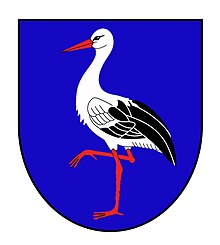Schilwazen (noble family)
The Schilwazen (also by Schilwazhausen , in the singular of Schilwaz or more rarely the Schilwarz ) are a Bavarian Uradelsgeschlecht . They have been extinct since the late Middle Ages. From the early 12th century to the 15th century they lived in the lower part of the Ilm between Geisenfeld and Vohburg an der Donau . There they built a moated castle (no longer existent today) and took up administrative, ministerial offices .
Coat of arms and residence
In the genealogical collections of Johann von Prey (1740) the Schilwazen are listed as lords of Schillwitzhausen , Engelbrechtsmünster and Ilmendorf , as well as of Oberwöhr , now part of Münchsmünster , and Irsching, now Vohburg . In Vohburg itself, too, their influence increased in the 14th century. Accordingly, they administered large parts of the Ilm floodplains in front of the confluence with the Danube.
The stork, which lives in the wet meadows of the floodplains, adorned their coat of arms. In her "Plauen Schilt, von Prey describes a white stork with a red beak" that lifts its right foot. The stork is still at home in nearby Geisenfeld today. His appearance is treated iconically there to this day.
Early Schilwazen
The first two detectable Schilwazen are the brothers Werner ("Wernherr") and Philipp von Schilwazhausen. The latter is said to have participated in the 10th tournament in Zurich (1165). Werner's son Dietmar (* around 1150) can be found with his father in documents for Weihenstephan (1181). Dietmar is considered to be the progenitor of the two Schilwaz lines that emerged at the end of the 12th century.
The two main lines
Starting from Dietmar's sons Arnold and Werner II. (Both * around 1185) there are two main lines of Schilwaz. Both lines extend into the 15th century and then quickly disappear again. Arnold's descendants dive as Schilwazen from Kösching and Wörth (probably Wöhr near Münchsmünster). The last Schilwazin of this branch is Anna von Schilwazhausen, who married the tournament knight Hanns von Leutenbach (today Leitenbach near Mainburg ) in 1410 . The "Volksbeckhs" were originally based at the Abens, but had, among other things, a rather capricious rule over Wackerstein on the Danube in the 15th century.
Werner II's line remains connected to the headquarters in Schillwitzhausen. She gets along with Albrecht (* 1210), Werner III. (* 1240), Wolfhart (* 1274), Eberhart (* 1310) and Stephan (* 1340, dates of birth are estimated). A strong bond with the von Hexenagger family - sometimes people marry in and then marry out again - can be guessed from the sources. The Schilwazen in Werner's line also married twice into the Achdorfer (near Landshut). There are marriages with those of von Öttling, von Aheim, von Gumppenberg, von Haslang and the Grülls.
Schilwazen in Vohburg
Wolfhart's son Heinrich (* 1310) is mentioned in the Bavarian tribal book by Wiguleus Hund (1595; Volume II) as Schilwaz von Vohburg. The 150-year-old Schilwazen influence in Vohburg begins with Heinrich, supported by the Wittelsbachers in Munich. On the Burgberg in Vohburg they are carers, such as Georg Schilwaz von Ilmendorf (1444), and marry into the local Gumppenberg house . During her time as a nurse in Vohburg, Duke Albrecht and the woman from Bernau married . Georg Schilwaz, son of Hanns Schilwaz zu Reichenberg and Lauging, died in 1484 as the last Schilwaz on the Vohburg sidelines. His sister Ursula sells her inheritance to Duke Albrecht IV.
At the beginning of the 16th century there are no longer any male descendants of the Schilwazen. Nevertheless, the descendants of female family members are documented even longer. Parts of the Gurren from Membach, Waal and Ebenhausen are descendants of the Schilwazen.
literature
- Johann Michael Wolfgang von Prey: Collection on the genealogy of the Bavarian nobility, in alphabetical order. Volume 24. Pages 202 ff., Freising 1740
- Wiguleus dog: Bavarian stem book. Second part. Pages 328 and 329, Ingolstadt 1598
Individual evidence
- ^ Johann Michael Wilhelm von Prey: Collection for the Genealogy of the Bavarian Aristocracy, in alphabetical order. Volume XXIV. Freising, 1740, page 202.
- ^ Johann Michael Wilhelm von Prey: Collection for the Genealogy of the Bavarian Aristocracy, in alphabetical order. Volume XXIV. Freising, 1740, page 203.
- ^ Johann Michael Wilhelm von Prey: Collection for the Genealogy of the Bavarian Aristocracy, in alphabetical order. Volume XXIV. Freising, 1740, page 204.
- ^ Wiguleus Hund: Bavarian Stammen-Buch. Second part. Ingolstadt, 1595, page 328.




